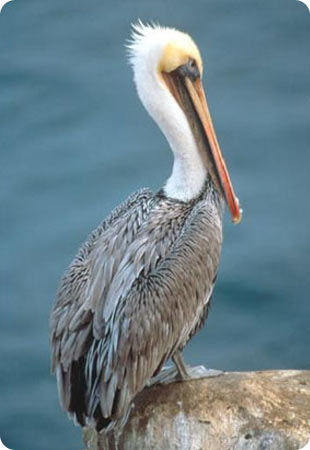The brown pelican is a common sight around piers and docks along much of the American coastline. But that wasn’t the case a few decades back -- the bird was on the verge of disappearing.
 Brown pelicans live only along bays and estuaries. Credit: U.S. Fish & Wildlife Service
Brown pelicans live only along bays and estuaries. Credit: U.S. Fish & Wildlife ServiceThe brown pelican is the only marine species of pelican -- it lives only along bays and estuaries, and not inland on freshwater lakes. And it’s also the only species that plunges into the water from the air. It scoops up as much as three gallons of water and fish, then drains off the water. Seagulls sometimes dart in and grab a fish out of the pouch -- and even perch on the pelican’s head to wait for a free snack.
The pelicans build their nests close to the water, either on the ground or in trees. Males and females take turns warming the eggs and feeding the chicks.
That location makes the brown pelican vulnerable to storms. But over the last century or so, its biggest threat has been people.
In the late 19th and early 20th Centuries, hunters killed thousands of them for their feathers. And later on, the birds were harmed by pesticides. When they ate fish that were contaminated with DDT, the pelicans produced eggs with thin shells. The shells easily cracked, so the population plunged, and the pelican was listed as an endangered species.
But DDT was banned, and other conservation measures were put into place. By late 2009, the population had swelled to about 650,000, so the brown pelican was removed from the endangered species list. The bird is once again a common sight along the American coastline.

